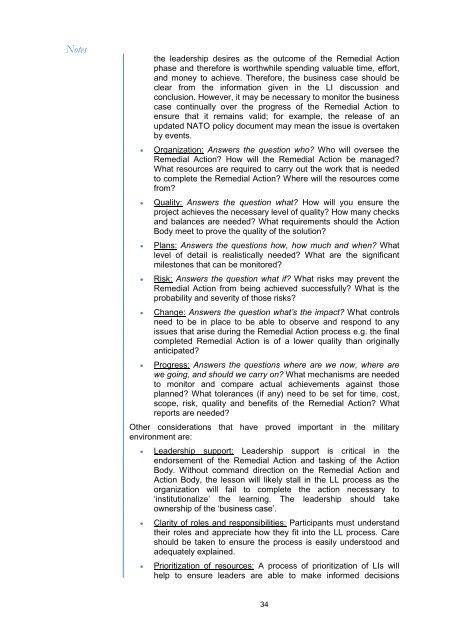JOINT ANALYSIS LESSONS LEARNED CENTRE NATO'S LEAD AGENT JOINT ANALYSIS
1ViofYb
1ViofYb
Create successful ePaper yourself
Turn your PDF publications into a flip-book with our unique Google optimized e-Paper software.
Notes<br />
<br />
<br />
<br />
<br />
<br />
<br />
the leadership desires as the outcome of the Remedial Action<br />
phase and therefore is worthwhile spending valuable time, effort,<br />
and money to achieve. Therefore, the business case should be<br />
clear from the information given in the LI discussion and<br />
conclusion. However, it may be necessary to monitor the business<br />
case continually over the progress of the Remedial Action to<br />
ensure that it remains valid; for example, the release of an<br />
updated NATO policy document may mean the issue is overtaken<br />
by events.<br />
Organization: Answers the question who? Who will oversee the<br />
Remedial Action? How will the Remedial Action be managed?<br />
What resources are required to carry out the work that is needed<br />
to complete the Remedial Action? Where will the resources come<br />
from?<br />
Quality: Answers the question what? How will you ensure the<br />
project achieves the necessary level of quality? How many checks<br />
and balances are needed? What requirements should the Action<br />
Body meet to prove the quality of the solution?<br />
Plans: Answers the questions how, how much and when? What<br />
level of detail is realistically needed? What are the significant<br />
milestones that can be monitored?<br />
Risk: Answers the question what if? What risks may prevent the<br />
Remedial Action from being achieved successfully? What is the<br />
probability and severity of those risks?<br />
Change: Answers the question what’s the impact? What controls<br />
need to be in place to be able to observe and respond to any<br />
issues that arise during the Remedial Action process e.g. the final<br />
completed Remedial Action is of a lower quality than originally<br />
anticipated?<br />
Progress: Answers the questions where are we now, where are<br />
we going, and should we carry on? What mechanisms are needed<br />
to monitor and compare actual achievements against those<br />
planned? What tolerances (if any) need to be set for time, cost,<br />
scope, risk, quality and benefits of the Remedial Action? What<br />
reports are needed?<br />
Other considerations that have proved important in the military<br />
environment are:<br />
<br />
<br />
<br />
Leadership support: Leadership support is critical in the<br />
endorsement of the Remedial Action and tasking of the Action<br />
Body. Without command direction on the Remedial Action and<br />
Action Body, the lesson will likely stall in the LL process as the<br />
organization will fail to complete the action necessary to<br />
‘institutionalize’ the learning. The leadership should take<br />
ownership of the ‘business case’.<br />
Clarity of roles and responsibilities: Participants must understand<br />
their roles and appreciate how they fit into the LL process. Care<br />
should be taken to ensure the process is easily understood and<br />
adequately explained.<br />
Prioritization of resources: A process of prioritization of LIs will<br />
help to ensure leaders are able to make informed decisions<br />
34



